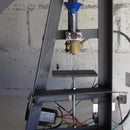Introduction: Hands Free Camber Gauge
Hands free Camber Gauge for cars made from angle iron, it can also be used to check castor too.
uses 2 small spirit levels and the read/write spindle and bearing from an old 250Mb hard drive for the pivoting plate and the spirit level.
Step 1: General Overview
The hands free part is provided by a section of innertube that uses 4inch nails bent to from "s hooks", and small 5mm irrigation tubing used on the nails to protect the car rims from damage.
The frame is constructed from 30mm equal angle iron, the pivoting plate made from some alluminuim swings on an old hard drive read/write head spindle.
I used 2 spirit levels, 1 a cheap plastic line level, and the other an even cheaper bubble level on the bottom less critcal axis
The design is a result of 2 sources of inspiration, Sheldon's Mazda Miata resource page, here http://www.quadesl.com/miata_alignment.shtml, a fine example of a well engineered product.
the other site is Rick Dormoi's site , showcasing his nice aluminum design
at http://www.toyheadauto.com/CasterCamberGauge.html
Step 2: The Frame
You will need a welder here, I used a total of 700mm of 30mm equal angle,
I've included a Sketchup file here for interest, thought I'd hop on the latest trend :)
I used M8 bolts at all 3 points where it touches the wheel rim, with slip on clear tubing for protection.. of the rim that is.
Attachments
Step 3: The Pivoting Plate
I found it easier to first mount the bearing on the angle frame, create an index mark to measure from on the frame, and then glue the top plate to the bearing.
the small spacer block under the thumbscrew was to lift up the short screw that I used, which increased the amount of uptravel on the ally plate.
In this configuration the gauge ranges from -15 degrees to +12 degrees.
Step 4: Side View
Side view of the top plate showing more use of my spaceage bonding process on the level and the bearing..CA glue and microballoons.. works quite well, even if I say so myself.
Also showing the index mark used to align the top plate to the frame index mark.
The distance between the screw and bearing is critical to accuracy of the completed gauge.
For my screw of 6M1.0 pitch 1 turn of the screw = 1mm, so the distance between must be 57.29mm to equal 1 degree.
the common metric sizes for interest are 6M1, 7M1 (at 57.29mm distance),
8M1.25 , 9M1.25 ( at 71.62mm distance),
10M1.5 ( at 85.94mm distance)
Step 5: In Use
It is possible to discern between 0.1 of a degree as shown in these 2 pics,
each of the 10 segments is .1 of a degree.
the arrowed segment pointing at the level indicates 0 degrees when the top plate is level with the frame edge, as is the trend with these devices.
if you flick back and forth between these 2 pics the approx 1mm movement of the bubble can be seen
Step 6: Revision of the 3 Rim Contact Points
After using the gauge some, I decided to toss the bolts with clear tubing method in favour of something better.
The bolts shift position on the rim, due to the curvature in the area where they usually put the balance weights, check the profile of the rim in the pic below.
This introduces an error of 0.4 of a degree every time the gauge is moved or replaced on the wheel.
My new method involves 15mm dia nylon feet slipped over the bolts, the larger footprint of the nylon gives a more repeatable reading and is also kinder to the rim than the old bolts were.
Step 7: Revision of the Frame Upright to Add More Functionality
Looking at the gauge I realised that by adding a small section of angle iron to the upright piece, the swivel plate with the level could be unscrewed and flipped around to the other side to measure level in the horizontal plane.
Instead of knowing whether or not an object is level, you would be able to determine its inclination in degrees
Who would need to know horizontal level to 0.1 degrees accuracy? ....
dunno not me, but its there if you need it :)
Step 8: Revision of Rubber Band Hold-down Method
After deciding the rubber band wasn't doing it for me cosmetically,
I have upgraded to a spring, it looks better and wont perish,
hopefully now I can leave well alone.














